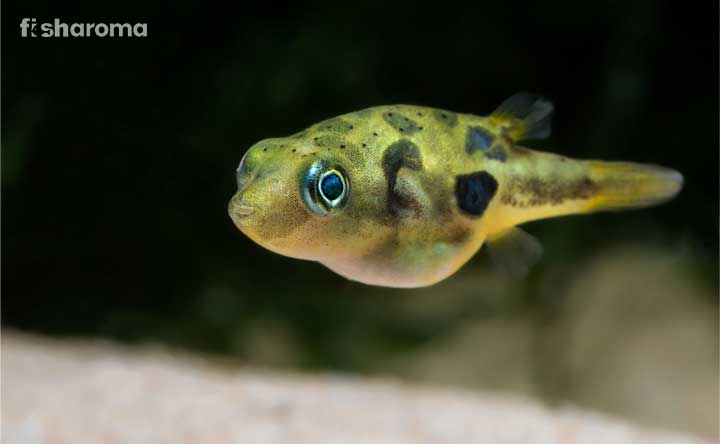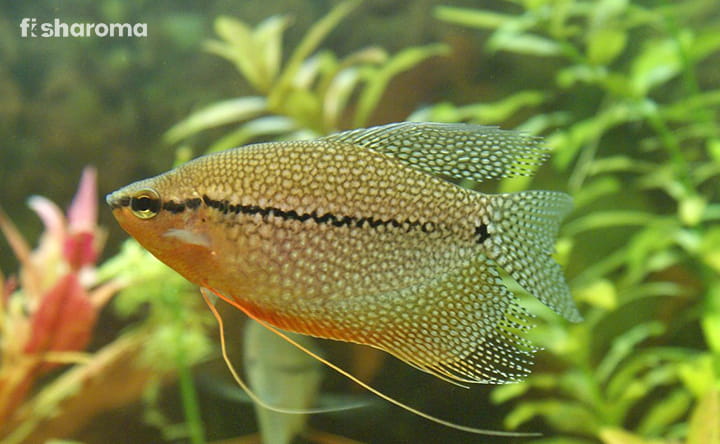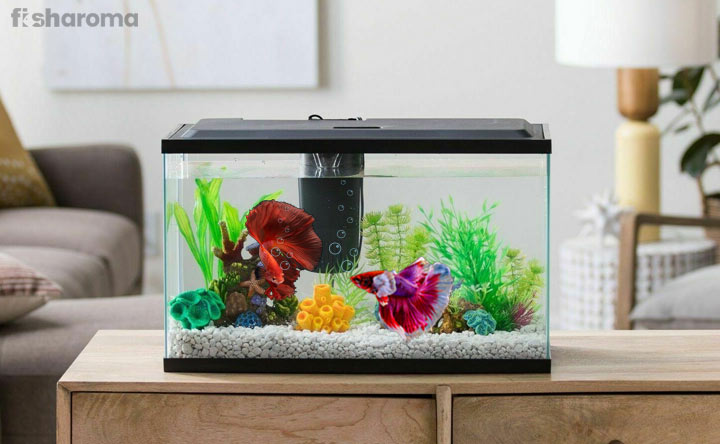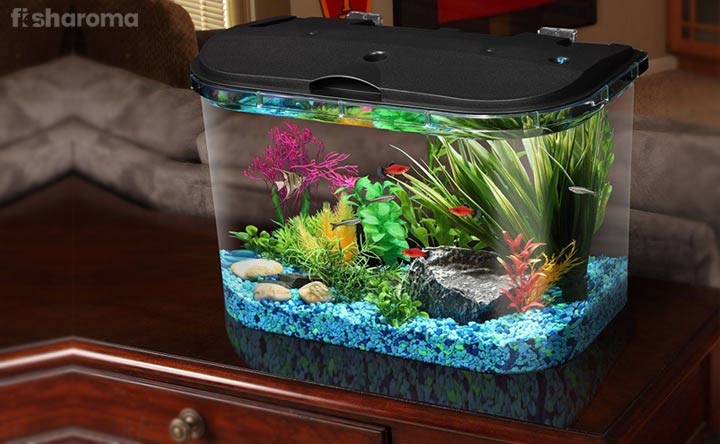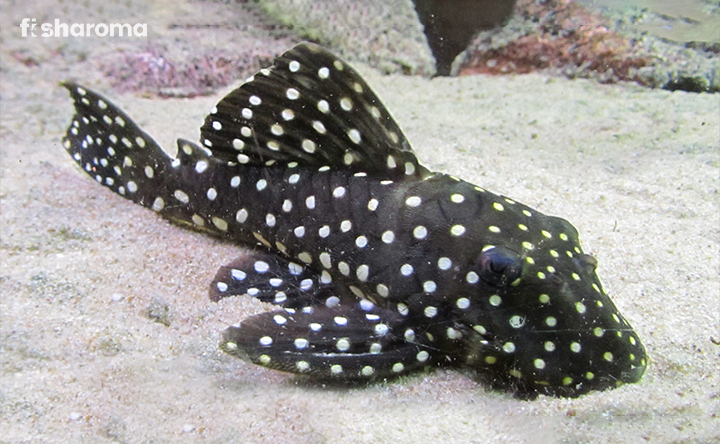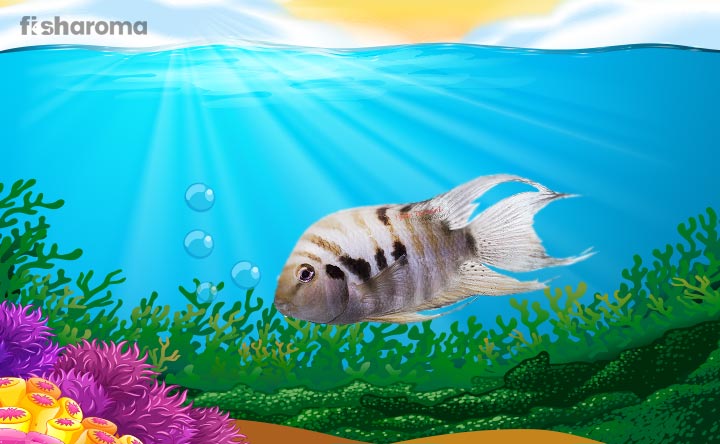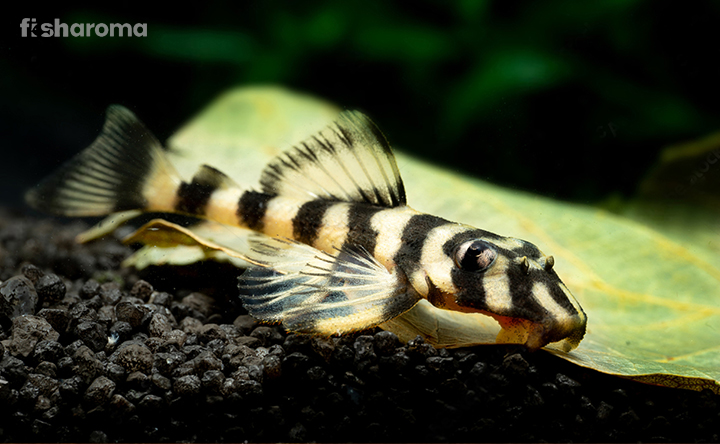Tinfoil Barb- A Complete Care Guide to these Gentle Giants
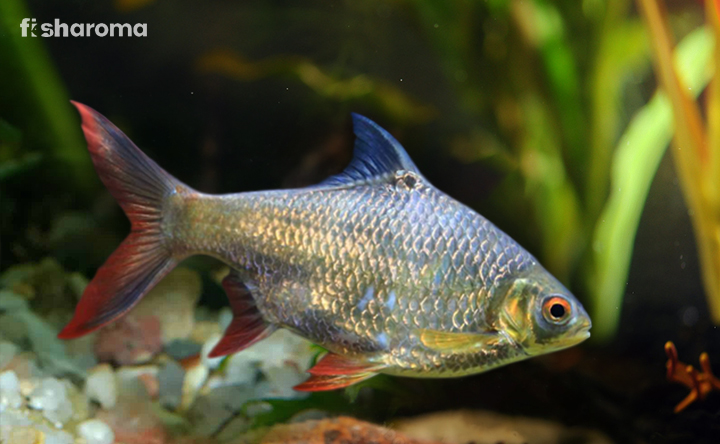
Tinfoil Barb is known by many other names like the Schwanefeld’s Barb, Goldfoil Barb and more other names like the Barbus schwanenfeldii, Puntius schwanenfeldi, and P. schwanefeldii , Barbodes schwanefeldi and Barbus schwanefeldi.
These Barbs are in the order of Cypriniformes, where they were initially known as Barbus schwanenfeldii and hence, their name of Schwanefeld’s Barb. They are extremely beautiful in the aquarium with a pretty easy care routine.
So, if you are planning to add them to your wonder aquarium, here’s everything you need to know about them in this complete care guide. Let us take you on this journey, where you learn everything about them in the easiest way possible.
Key Specifications
Here goes a few key elements you need to check before you get started:
| Scientific Name | Barbonymus schwanenfeldii |
| Origin | Mekong & Chao Phraya basins, Thailand, Borneo, Malayan Peninsula and Borneo. |
| Lifespan | 8-20 years |
| Colours/Patterns | Silvery glazed body, with orange and black accents. |
| Temperament | Semi-aggressive but mostly peaceful. |
| Size | 1-2 inches (Juvenile), 13.8-14 inches (Adult) |
| Diet | Omnivorous |
| Family | Cyprinidae |
| Compatibility | Compatible in a community. |
| Tank size | 70 gallons |
| Care level | Easy-Moderate |
| Water preference | Freshwater |
Overview
Tinfoil Barb (Barbonymus schwanenfeldii) is a lovely freshwater fish from the Cyprinidae family. These tranquil creatures have great compatibility in a community, where a preferred tank mate would be of a large, peaceful fish species. Their care regime is not the hardest, as it can be performed by most beginner or seasoned aquarists. The lifespan of these Barbs are pretty great too, so let us give you more reasons as to why you should make them your brand new tank addition.
Origin and Habitat of Tinfoil Barb
These beautiful Barb species, known by the name of Tinfoil Barb are Southeast Asian fishes, mostly found in Thailand, Sumatra, Malayan Peninsula and regions of Borneo, Vietnam, Laos. To be more precise with their place of origin, they are majorly based off of rivers, canals, ditches and streams like Mekong and Chao Phraya Basins. Other than all these water bodies, you can find them in the flooded paddy fields or plain flooded regions.
Seems like these Barbs really like a gentle flow of water, if you briefly study the water flow type in their natural habitat. The water temperature in their place of origin is warm with a pretty strong current. This is something really important for you to know, especially while replicating their in-tank conditions.
The Tinfoil Barbs are also known as the “gentle giants” for their swift adaptability with strong currents in their natural water origin. However, despite their size, they are pretty good swimmers who are able to deal with strong water flow.
Appearance of Tinfoil Barb
The Tinfoil Barb fishes have pretty noticeable oversized scales over their silvery glazed body. They are known as the “Tinfoil” Barb for a reason, as in pristine waters they look like actual tinfoils! Incredible, isn’t it? Other than that, their body is pretty reflective of light, which makes them shimmer in your aquarium.
Let’s cut down their outward appearance details and have a closer look:
Colour
These ornamental beauties have heavily accentuated reddish tail region, especially the Barbonymus altus, who are segregated for their unique colour contrasts. The beautifully red strokes of colour around the anal fins and the pelvic fins never fail to fetch your attention. It may sometimes appear a little orangish due to light play.
Other than that, there’s black-bordered detail on the edges of the tail and the fins. You can also find Albino Tinfoil Barb variants, specially bred on demand of fellow aquarists.
Besides all these, there’s a Glass Tinfoil Barb variant who possesses a completely transparent appearance, which is indeed a majestic fish to have around your very own community of fishes. Out of all the known colour variants, the Golden Tinfoil Barb is the most significant one on demand.
Size
The Tinfoils are from the genus Barbonymus, as found by Bleeker in the year 1853. But our subject matter here is the size. Well, they grow as big as 14 inches which is evidently on the bigger side. However, at the time of purchase as juveniles they are only about 1-2 inches, but they have a rapid growth rate. Your beauties will grow in no time!
Behaviour of Tinfoil Barb
Tinfoil Barb fishes can be categorically peace loving, but that does not make them any less active. We assure you that this majestic fish species will always keep you entertained with something or the other. Don’t worry, their rich activity does not limit them from existing peacefully with other docile fish species, unless they are overwhelmed by their large appearance or activity. These major multi-region dwellers can be seen swimming in both the bottom and middle layer of your tank.
Just make sure you give them an aquarium that’s large enough to support their presence. If we try to give you a compact discussion on their behaviour, they are mild species with a balance of behaviourisms. Just make sure to keep them away from fishes with long, flowy and graceful fins as they won’t hesitate to nip them, being prominent fin-nippers.
Sometimes, they turn into opportunistic feeders, feeding on small fishes who can’t defend themselves. Make sure you make them face fishes like angelfish or bettas to protect their aesthetic fins or tails. It’s always good to keep these fishes in groups of 6. Still in that case, you will need to compensate for the tank size and increase it. Each Barb should have enough room to not feel claustrophobic or stressed in any way. More Tinfoil Barb fishes you keep together, the more content they will be in their captive existence.
Lifespan of Tinfoil Barb
The classic lifespan of the Tinfoil Barb fish species is 10-15 years. In some cases, it has been noticed they tend to live as little as 8 years or even as long as 20 years. Hence, it really depends upon how much care you provide them.
Diet of Tinfoil Barb
It is true, they are omnivorous species. So much so that they even tend to feed on small feeder fishes or weak fish species who can’t protect themselves against their comparatively bigger frame. Still, if you have a closer look at their preference, they are more into the herbivorous diet.
One thing you must note, is that in captivity they are not picky about eating at all. These Tinfoils would almost feed on anything that will fit their mouths, being greedy eaters.
A closer look at their diet for you to understand better:
Herbivorous preferences-
- Submerged Land Plants
- Aquatic Macrophytes
- Filamentous Algae
- Other vegetarian food items like cucumber, lettuce, spinach and more.
Omnivorous picks-
- Insects (Occasionally Mosquito Larvae)
- Small fish
- Worms (Bloodworms or similar, but chopped)
- Crustaceans (Brine Shrimp or other cultured live fish food)
Store-bought choices-
- Fish flakes
- Fish pellets
- Other frozen fish food
Tank Requirements for Tinfoil Barb
To take care of the tank requirements is extremely important. These are the footnotes you need to be well-accustomed to, while taking care of any exotic fish species under captive situations. So let’s have a look at what are the necessary tank requirements you have to care for, while taking care of the wonderful Tinfoil Barb fish species!
Tank Lid
As we’ve already gathered from properly studying their behaviourisms, Tinfoil Barbs are quite active, no matter how peace-loving they may be. You will see them dwelling in both the middle and bottom layers of your aquarium. This poses a potential risk of them falling out to their deaths, in which case a Tank Lid or Hood is really important.
Tank Size
The minimum tank size needs to be at least 70- 75 gallons for these giant lovelies to dwell in comfort. However, if you plan on increasing the numbers, make sure you increase the tank size accordingly. Even if it’s a community tank, you have to remember to expand your tank accordingly, besides the segregated tank requirements of other fishes. In a typical school of Tinfoil Barb, a 200-gallon tank or more is well-suited.
Substrate
Remember to include stones as a part of the substrate. The stones so-included should not be rough, as they can hamper the precious skin or Barbels of the Tinfoils. A smooth, stony substrate, emulating their natural habitat of river shores works just fine.
Filter
It is evident that these giants produce a significant amount of toxic waste. If that organic waste matter gets accumulated with the tank water, it’s equally detrimental to their health, as it is to the rest of the community. It’s best to opt for a strong filter that can support the big tank these Tinfoil Barb fishes are kept in. A Canister filter is a really good choice of filters for a Barb tank. This ensures that there’s proper oxygenation and aeration in the aquarium water.
Ornaments
You can add a few add-on structures here and there, as a part of these fishes’ tank decoration or choice of ornaments. It would be best to add driftwood instead along with a few choice aquatic plant options. You will study more about them below!
Lighting
Keep the lighting on the lower side, tops moderate. The Tinfoil Barbs already have a glimmery appearance, which reflects most of the light. That looks extremely beautiful. But if the lighting intensity is too much, it can not only stress the fish out, but the immense reflection can overwhelm the other fishes in the community. So it’s best to keep the lighting intensity balanced or low.
Presence of Flora
As we’ve gathered from properly studying their diet above, Tinfoil Barbs are to feed on anything they can. That includes even plant matter, which leaves a possibility of them consuming aquarium plants. It’s best to make your choice of plants the hardiest. At least enough to withstand the raid of these fishes. You can just go for floating aquarium plant choices, as it is not possible for them to come to the surface and feed on surface tank plants. Nice low-light freshwater aquarium plant variants are the best to go with.
You can choose plants like:
& more.
Cleaning Method
Make sure you use a test kit every now and then in order to keep everything in check. Perform a proper water replacement procedure on alternate durations, as their toxic waste production is high.
Clean the tank walls with a soft cotton cloth and keep an eye out for waste accumulation in the corners of the tank. A proper cleaning method, performed in timely durations is really important for their health.
Water Type for Tinfoil Barb
Water Parameters are of utmost importance. It’s one of the most significant segments, while trying to maintain a proper aquarium health.
The important water parameters needed for Tinfoil Barb:
| Hardness | 9-30 dGH, 2-10 KH |
| Temperature | 22-26 Degrees Celsius (Max 28 Degrees Celsius) |
| pH | 6.0-7.5 |
Hardness
These hardy fishes prefer a carbonate hardness of 2-10 KH, whereas the general hardness should be about 9-30 dGH. In terms of general hardness, it’s best to keep it around 10 dGH. Usage of certain natural elements or even chemicals is common to achieve the perfect water hardness, by some aquarists or practitioners in the hobby.
Temperature
Seems like the temperature range is not that wide when it comes to the water of a Tinfoil Barb tank, make sure the temperature stays constant between 22-26 Degrees Celsius. Always monitor the warmth of the aquarium water, as too warm or cold waters can seriously hamper the health of these Tinfoils.
pH
Tinfoil Barb fishes prefer their waters to be slightly on the acidic side or simply neutral. So remember to maintain a pH range of 6.0-7.5, for perfect results and best health reflections.
Compatibility of Tinfoil Barb
Tinfoil Barbs are generally peaceful fish species, who are mostly compatible with tank mates of similar size or even bigger than them. It’s best to keep them in a large aquarium, with other large fish species or similarly sized fish species, as they may just look at smaller or weaker fishes as food.
Suitable Tank mates
Let’s have a look at their suitable tank mates:
and more.
Unsuitable Tank mates
Just keep the Tinfoil Barb fishes away from small fish species or feeder fishes like Cardinal Tetra fish and more. Even some small bottom-dwellers may end up becoming their meal like Shrimp species or certain small snails.
Breeding of Tinfoil Barb
However, it is not possible to breed these beauties at home, there have been instances of them breeding commercially. Basically, in special warehouses or culture grounds, they can be bred professionally. These fishes are quite large, hence, their breeding process is not the easiest to just perform just by any amateur aquarist at home.
The Tinfoil Barbs can be spawned with hormones, so applied in aquaculture projects in certified zones. The breeding tank requirement is huge, with enough space to separate the juveniles from the parent fishes. It’s not impossible to breed Tinfoil Barbs, but an average aquarist can’t really perform it with ease. Remember to increase the breeding tank temperature as it encourages breeding. After which you will notice that the female fish can lay around 1000 eggs at a time.
The male fish fertilizes it afterwards, when the onset of the breeding procedure is complete. The eggs are scattered all over a particular region in the aquarium. Make sure you remove the breeding parent fishes from the tank, as they possess no parental instincts and may consume the eggs. The Juveniles can be fed with bite-sized feedable like baby brine shrimp, infusoria and similar food items for packed nutrition.
Diseases of Tinfoil Barb
These Tinfoils are prone to most aquarium freshwater diseases that affect fishes in the tank. So be careful for the most common ones, that include:
- White Spot Disease or Ich
- Gold Dust Disease or Velvet
- Dropsy
- Fin rot
Symptoms that represents that your Barb is suffering from either or most of the above-mentioned diseases:
- Unusual white spots or blotches on the skin of the Barbs.
- Shortness in breath
- Fastened up or frequent gill movement, which almost seems abnormal.
- Loss of Appetite
- Significant signs of irritability
- Lethargy
- Withdrawal from other Barbs in their own group.
- Granules like salt on the body.
- Destroyed fins, with a ripped appearance.
- Slight or enhanced breeding on edges of the fin.
- Internal organ destruction, like the kidneys of the fish.
- Bloating
- Abnormal swimming patterns in the extreme bottom layer of the tank.
- Fading colouration.
- Ulcers on the skin and gills.
& more.
Treatment
You must be wondering “What can be done to treat the ill fish?”. Don’t worry, as we got you covered with the ultimate treatment techniques you can perform immediately. But disclaimer! Do contact your nearest vet if you feel like the situation of your sick water buddy is out of control. So let’s see what are the essential treatment methods that you can do immediately.
- Increase the water temperature.
- Separate the ill fish from the rest of the community. This prevents the further spread of the disease to other healthy fishes.
- Copper-based medication for specific diseases like Gold dust.
- Use aquarium salt in cases of disease of fin rot.
- Keep an eye out for early detection of ailment symptoms.
- Maintain the tank water’s hygiene.
- Keep the essential water parameters in check.
Summary
Tinfoil Barbs are like actual Tinfoils in your aquarium, which are unique to look at. Their mesmerizing beauty, along with their gentle swimming pattern combined with large size looks visually pleasing. If you want to increase the aesthetics of your tank, Tinfoil Barb or even the Golden Tinfoil Barb is the right fish for you.
You can see them swimming about the entirety of your tank in schools, having their very-own personality distinguishing them from the rest of the community. So what are you waiting for? Get these lovely Barbs in your aquarium right now and let us experts guide you through your caregiving journey in the hobby.
Similar Care Guides You May Like
- Electric Yellow Cichlid Care Guide: This South African beauty is similarly vibrant, with an easy care regime. On top of that, they are extremely comfortable in a community of fishes. Know more about them here!
- Golden Wonder Killifish Care Guide: Their slender look with a bright colour contrast is truly rewarding to witness in the tank. Want to know more about them? Click right here.
- Female Betta Fish Care Guide: Don’t just be mesmerized by the male variant’s skirt-like beauty, the Female Betta is no less with their beauty. Additionally, they’re not as temperamental. Check this out!

